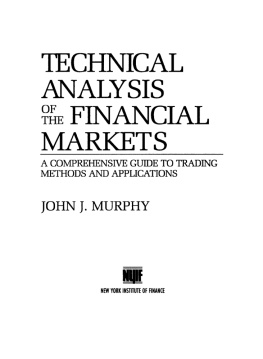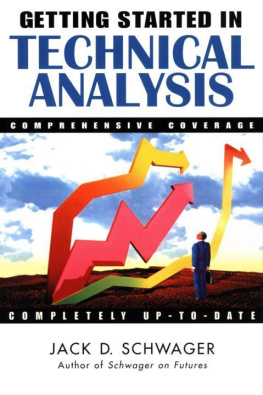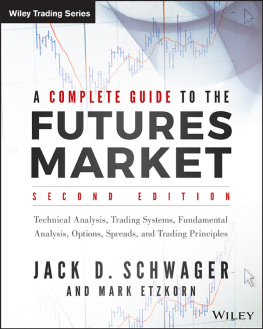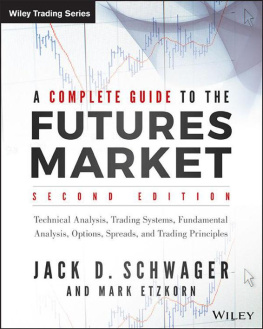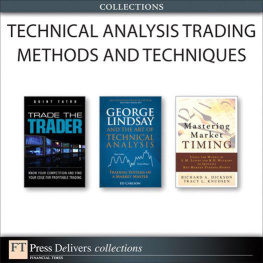Technical Analysis of Gaps
Identifying Profitable Gaps for Trading
Julie R. Dahlquist
Richard J. Bauer, Jr.
Vice President, Publisher: Tim Moore
Associate Publisher and Director of Marketing: Amy Neidlinger
Executive Editor: Jim Boyd
Editorial Assistant: Pamela Boland
Operations Specialist: Jodi Kemper
Assistant Marketing Manager: Megan Graue
Cover Designer: Alan Clements
Managing Editor: Kristy Hart
Senior Project Editor: Lori Lyons
Copy Editor: Apostrophe Editing Services
Proofreader: Kathy Ruiz
Indexer: Lisa Stumpf
Compositor: Nonie Ratcliff
Manufacturing Buyer: Dan Uhrig
2012 by Julie R. Dahlquist / Richard J. Bauer, Jr.
Pearson Education, Inc.
Publishing as FT Press
Upper Saddle River, New Jersey 07458
This book is sold with the understanding that neither the author nor the publisher is engaged in rendering legal, accounting, or other professional services or advice by publishing this book. Each individual situation is unique. Thus, if legal or financial advice or other expert assistance is required in a specific situation, the services of a competent professional should be sought to ensure that the situation has been evaluated carefully and appropriately. The author and the publisher disclaim any liability, loss, or risk resulting directly or indirectly, from the use or application of any of the contents of this book.
FT Press offers excellent discounts on this book when ordered in quantity for bulk purchases or special sales. For more information, please contact U.S. Corporate and Government Sales, 1-800-382-3419, .
Stock charts created with TradeStation. TradeStation Technologies, Inc. All rights reserved.
Company and product names mentioned herein are the trademarks or registered trademarks of their respective owners.
All rights reserved. No part of this book may be reproduced, in any form or by any means, without permission in writing from the publisher.
Printed in the United States of America
First Printing June 2012
ISBN-10: 0-13-290043-2
ISBN-13: 978-0-13-290043-0
Pearson Education LTD.
Pearson Education Australia PTY, Limited.
Pearson Education Singapore, Pte. Ltd.
Pearson Education Asia, Ltd.
Pearson Education Canada, Ltd.
Pearson Educacin de Mexico, S.A. de C.V.
Pearson EducationJapan
Pearson Education Malaysia, Pte. Ltd.
Library of Congress Cataloging-in-Publication Data
Dahlquist, Julie R., 1962
Technical analysis of gaps : identifying profitable gaps for trading / Julie R.
Dahlquist, Richard J. Bauer, Jr.
p. cm.
ISBN 978-0-13-290043-0 (hbk. : alk. paper)
1. StocksCharts, diagrams, etc. 2. Technical analysis (Investment analysis) I.
Bauer, Richard J., 1950- II. Title.
HG4638.D34 2012
332.632042dc23
2012010828
To Katherine and Sepp
Acknowledgments
We first started looking at gaps because they provide useful illustrations when teaching our students how to read stock charts. Students hear a news report that their favorite company just reported earnings, that a company is being sued, or that a well-known company, such as Apple, is launching a new product and ask how these events will affect the price of the stock of the company. These news events often trigger sizeable price moves, frequently on a gap. We can introduce the concept of a gap easily and quickly and then use the conversation as a jumping-off point for broader discussion of the tools of technical analysis.
Gaps repeatedly come up during small talk when people find out that we have a background in technical analysis. Even individuals who know little about the stock market seem to have heard the adage the gap is always filled. The two technical analysis terms that people seem to latch on to are head and shoulders and gaps. After engaging in a number of these conversations, we thought it would be interesting to pursue this topic a bit more. Gaps seem to have captured the attention of the earliest technical analysts, but we found surprisingly little systematic study of gaps. Much of the recent work in the area of technical analysis has been based on complex mathematical models. We thought it would be a fun and interesting endeavor to investigate one of the simple, basic ideas of technical analysis in more depth. Thus, a couple of years ago we began our inquiry.
In the beginning, we thought we would engage in a simple study that would provide some interesting stories regarding gaps to use in our classrooms. As we started looking at gaps, our appreciation for their use as a tool of technical analysis grew and our inquiry grew. In May 2011, we were honored as recipients of the Market Technicians Associations Charles H. Dow Award in Technical Analysis for our paper, Analyzing Gaps for Profitable Trading Strategies. We realized that in our paper we had only been able to scratch the surface of gaps. Our editor, Jim Boyd, suggested we continue our investigation in the form of a bookthe result of which you are holding in your hands.
We are indebted to a number of people who helped us learn more about gaps and who helped put this knowledge together in the form of this book. First, we are indebted to Charlie Kirkpatrick for all the support and assistance he has given us in learning about technical analysis over the years. His knowledge and patience are endless. Ellie Kirkpatrick, Charlies wife, is the greatest cheerleader anyone could have in their corner. She continues to motivate and inspire us. We thank both Charlie and Ellie for the endless list of things that they have done for us and our children.
We would like to thank Fred Meissner and Hank Pruden for their support and encouragement. They are both stellar examples of the friendliness and warmth exhibited by many in the technical analysis community. They, too, have been especially kind to our children. Thanks to all those who work in the MTA office, especially Tom Silveri, Tim Licitra, and Shane Skwarek. This project has benefited from conversations with members of the MTA through electronic discussion groups, webinars, and meetings across the worldfrom Houston to Prague. A special thanks to Robert Colby and Ralph Acampora for answering questions along the way. Thanks, also, to Norgate Investor Services for granting us permission to publish our results, which were based on their stock price data marketed as Premium Data.
We are grateful to the Pearson staff, especially executive editor Jim Boyd, managing editor Kristy Hart, and senior project editor Lori Lyons for their hard work and dedication in bringing this project to fruition.
We have dedicated this book to our children, Katherine and Sepp. They challenge, inspire, and entertain us in innumerable ways. It is bittersweet watching our children grow up. We miss their younger versions, but our relationship with them both deepens and becomes more meaningful and special with each passing year. We feel richly blessed with the honor of being their parents.
Julie and Richard
Being able to undertake a project like this requires the encouragement and support of family, teachers, friends, and colleagues over a number of years. Thanks to my mom for encouraging me to pursue studies in economics and finance, although she claims not to understand anything about it herself. Thanks to my sisters, Carrie and Katie, for being there to laugh about old family stories whenever I need a break from work. Good luck to my nephew, John, as he embarks upon his college career!
Julie
I want to thank family members for their support. I thank my father, Dick Bauer, for his continued love and encouragement. He has also given me an appreciation for dedication, perseverance, and striving for excellence. I also thank Amy and Mary for their ongoing love and support. I look forward to seeing the paths taken by Jake, Sophia, Joshua, Grant, and Lucy; they have incredible parents. Thanks to Don, Ruth, and Brenda for all of their encouraging words.







